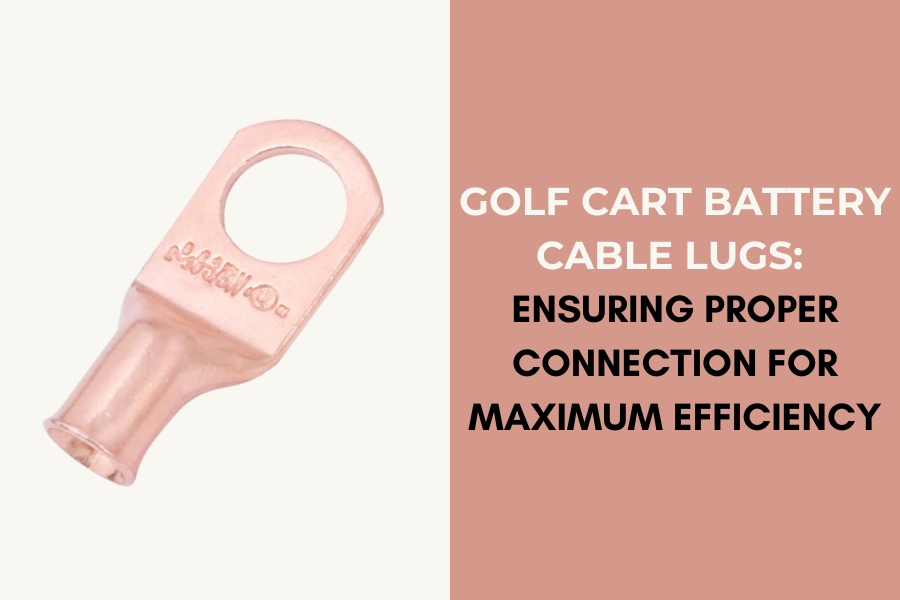Golf Cart Battery Cable Lugs: Ensuring Proper Connection for Maximum Efficiency

Golf carts, whether used for leisurely rides on the golf course or practical transportation in gated communities, rely heavily on their battery systems for power. One often overlooked but crucial component in these systems is the Golf Cart Battery Cable Lugs. These small yet essential parts ensure that the electrical connection between the battery and the motor is secure and efficient. Understanding the importance of battery cable lugs and how to maintain them can significantly enhance the performance and longevity of your golf cart.
What are Battery Cable Lugs?
Golf Cart Battery Cable Lugs are the connectors at the ends of battery cables that attach to the battery terminals. These lugs facilitate the transfer of electrical current from the battery to the golf cart’s motor and other electrical components. They are typically made from conductive metals such as copper or aluminum and are designed to handle high currents without significant resistance or heat generation.
Importance of Proper Connection
1. Optimal Performance: The efficiency of a golf cart’s electrical system depends on the quality of the connections between the battery and the motor. Poor connections can lead to voltage drops, reducing the power available to the motor and other systems. This can result in sluggish performance, shorter driving range, and reduced battery life.
2. Safety: Loose or corroded connections can generate heat due to increased electrical resistance. This heat can damage the battery, cables, and surrounding components, posing a fire hazard. Properly installed and maintained battery cable lugs help prevent such risks.
3. Longevity: Good connections ensure that the battery and motor operate within their designed parameters, reducing wear and tear. This can extend the lifespan of both the battery and the motor, providing better value and reducing the frequency of replacements.
Choosing the Right Cable Lugs
When selecting battery cable lugs for a golf cart, consider the following factors:
1. Material: Copper lugs are commonly preferred due to their excellent conductivity and durability. They are less prone to corrosion compared to aluminum lugs, making them suitable for the varying environmental conditions golf carts often encounter.
2. Size: The lug size must match the cable size and the terminal size on the battery. Using the correct size ensures a snug fit and optimal contact area, reducing the risk of loose connections and high resistance.
3. Type of Connection: Lugs can be crimped or soldered to the cable. Crimping involves compressing the lug onto the cable using a crimping tool, creating a mechanically strong and electrically efficient connection. Soldering involves melting a filler metal (solder) to bond the lug to the cable, which can provide a solid connection if done correctly. Crimping is generally preferred for its ease of installation and reliability.
Installation Tips
1. Cleanliness: Ensure that the battery terminals and cable ends are clean and free from corrosion before attaching the lugs. Use a wire brush or sandpaper to clean the surfaces if necessary.
2. Proper Tools: Use the appropriate crimping tool for the lug size to ensure a secure and effective crimp. If soldering, use a high-wattage soldering iron to ensure proper heating and a solid bond.
3. Heat Shrink Tubing: After attaching the lugs, cover the connection with heat shrink tubing. This provides additional insulation and protection against moisture and corrosion.
4. Regular Inspection: Periodically inspect the battery cable lugs for signs of wear, corrosion, or looseness. Tighten any loose connections and clean or replace corroded lugs to maintain optimal performance.
Maintenance for Longevity
1. Regular Cleaning: Clean the battery terminals and lugs periodically to prevent corrosion buildup. Use a mixture of baking soda and water to neutralize any acid residue and rinse thoroughly.
2. Tight Connections: Ensure that the lugs are tightly connected to the battery terminals. Loose connections can cause arcing and increase resistance, leading to heat buildup and potential damage.
3. Corrosion Prevention: Apply a thin layer of petroleum jelly or a commercial terminal protector to the battery terminals and Golf Cart Lug Stud to prevent corrosion. This simple step can significantly extend the life of the connections.
4. Replacement: If you notice any signs of severe wear or damage, replace the battery cable lugs promptly. Using worn or damaged lugs can compromise the entire electrical system of the golf cart.
Conclusion
Golf Cart Lug Stud might be small components, but they play a critical role in the performance and safety of golf carts. Ensuring proper connection through the use of high-quality lugs, correct installation, and regular maintenance can lead to maximum efficiency and longevity of the battery and motor system. By paying attention to these details, golf cart owners can enjoy a smoother, safer, and more reliable driving experience.







